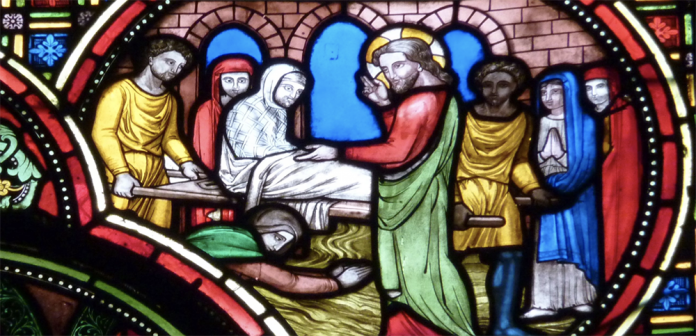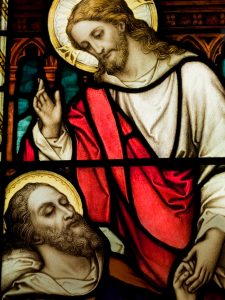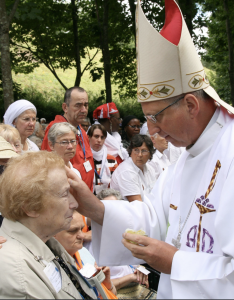
Catechize with Scripture, signs, prayers, and experiences
JEANNE HUNT
Anointing of the Sick is a very positive encounter with our God of hope. God is a loving creator who wishes to restore us with his love. Anointing of the Sick is a rite of healing, strengthening, and compassion. As we teach about this sacrament, we should connect student learning with the graces that can bring a strengthening for ongoing perseverance — and possibly a restorative energy — to the person who suffers. To teach this, we need to revisit the learning styles and catechize with sight, sound, and movement so the inner workings of this sacrament are revealed to our students.
Share the stories
Critical to our understanding of this sacrament is the directive we find in the New Testament from the Apostle James. St. James wrote:
Is anyone among you sick? He should summon the presbyters of the church, and they should pray over him and anoint [him] with oil in the name of the Lord, and the prayer of faith will save the sick person, and the Lord will raise him up. If he has committed any sins, he will be forgiven. (James 5:14-15)
The early Church, when James wrote, was patterning their practice on the example of Jesus. And we can explore the healing works of Jesus with our students, too, as one of the best tools for catechesis is storytelling.
The Sacrament of Anointing of the Sick is the perfect showcase for stories of faith. While we may not always remember what we have read in the textbook, faith stories seem to stay with us. The Gospel is full of Jesus’ healing stories. The themes of recovery and restored health in Scripture are the perfect place to explore the power of this sacrament. No matter the age of our students, we should always include Scripture in our lesson plan.
 In the New Testament, we encounter Lazarus, the woman with the hemorrhage (see Luke 8:43-48), the son of the widow of Naim (see Luke 7:11- 17), Peter’s mother-in-law (see Luke 4:38-39), and many more.
In the New Testament, we encounter Lazarus, the woman with the hemorrhage (see Luke 8:43-48), the son of the widow of Naim (see Luke 7:11- 17), Peter’s mother-in-law (see Luke 4:38-39), and many more.
For young children, use story Bibles. When sharing Scripture with older students and adults, be sure to use a good translation (such as the NABRE or NRSVCE). As we incorporate Scripture in each lesson, we serve two purposes: We better familiarize the class with the Bible, and present true images of the healing Christ.
Another Scripture-based tip that can reinforce the theology of this sacrament is to allow intermediate grades and junior high students to create miracle plays. Younger students love to act out the Gospels. Find scripts online for short plays based on the healing miracles of Jesus — or create some! It is fun to allow small groups to plan their play and present them at the end of the teaching unit. Following each play, discuss it as if it were a Hollywood production:
■ What would you call this play?
■ What did you feel when Lazarus walked out of the tomb?
■ With which character do you most closely identify?
St. Ignatius offers another way to engage our students with Scripture. He suggests a method of applying our imagination to the careful reading of the text, while placing ourselves within the action of story. This can offer fruitful discussion:
■ Who was I in the story?
■ What did I see around me?
■ What did I experience?
■ Did any word or phrase in the story have a particular meaning for me?
Older students can write their own version of the Scripture stories, as if they were a part of the scene. Invite the class to a quiet time and read the meditation as a new way to pray with Scripture. Additionally, for older students or adults, you can find a resource for a guided meditation using a healing story.
Psalms and saints
Ask older students and adults to take a short phrase of compassion from the Psalms and reflect on it. (Try Psalm 51:1, 103:13, 116:5, 119:156, 145:9.) If you teach in a Catholic school, these reflections can become an inspiring writing assignment when integrated into language arts classes. At its best, this exercise helps us encounter the presence of a healing God.The Sacrament of the Anointing of the Sick is an experience that enfolds the suffering person in the Lord’s compassionate love. Psalms can reinforce this focus and help us to understand the grace of this sacrament. The Psalms are the place where God’s compassion is so very apparent.
Many saints are vehicles of God’s healing power via their powerful intercessions.
Another great source of inspiration as we study this sacrament are the healing stories of the saints. Many saints are vehicles of God’s healing power via their powerful intercessions. Also, the miracles of Lourdes and other Marian sites add to the long history of miraculous healings in the Church.
Invite a guest to class
In addition to Scripture, allow students to listen to a live witness. Most students have never experienced or seen this rite performed. Inviting a recipient to share a description of what happened during the sacrament is helpful and instructive. This witness has wonderful benefits: The visit brings a message of hope and comfort, and students become familiar with the rite.
We can find this witness among our own circle of friends and family or those of your students. Better still, talk to a parish priest who might be able to recommend someone right in your own faith community. Or perhaps the priest may have time to visit your class and share about Anointing of the Sick from the priestly point of view. (Click this link for a short film about youth experiencing this sacrament.)
Outward signs
Every sacrament is accompanied by outward signs. The old Baltimore Catechism says a sacrament is an “outward sign instituted by Christ to give grace.” These physical signs and actions represent a profound movement of grace in the recipient. In the Sacrament of Anointing of the Sick, these outward signs are the laying on of hands by a priest and the anointing of the sick or suffering person with holy oil. Coupled with prayer, each action brings to the sick or dying the grace of healing and strength.
Our classrooms should become a showcase of these signs when we present a unit on this sacrament. If you have a prayer table, perhaps it can have a carafe of oil, a photo of the laying on of hands, a photo of a priest anointing someone, or an image of Jesus healing a person.
 Teach your students about the sacred nature of the sacramental oil. Oil has long been symbolic of healing and strengthening. A priest’s anointing of a person in the sacrament is meant to be a healing balm. He anoints the person while offering prayers of healing.
Teach your students about the sacred nature of the sacramental oil. Oil has long been symbolic of healing and strengthening. A priest’s anointing of a person in the sacrament is meant to be a healing balm. He anoints the person while offering prayers of healing.
Every year at the annual Chrism Mass, the bishop blesses the oils that parish priests will use to celebrate the sacraments. The Oil of the Infirmed, also called the Oil of the Sick, is used for the Anointing of the Sick. It is pure olive oil, and it is different from the Oil of Catechumens that is used before Baptism or the sacred chrism oil used at Baptism, Confirmation, or Holy Orders.
See if the parish will allow your students to experience the fragrance and the feel of the Oil of the Sick. It might be good to take them into your local church to see the Olea Sancta (a box for storing of the three holy oils). If possible, let them smell the oil used in the anointing.
Short of visiting the church, with younger students you can offer a hands-on experience of oil in the classroom setting by using baby oil. The catechist can make the Sign of the Cross on the student’s palm, while explaining that this is not holy oil, but simply fragrant oil that feels good, like the oil we use in the sacrament. Afterward, talk about how this oil reminds us of the beautiful anointing oil a sick person experiences in the sacrament.
 The second sign in the Sacrament of Anointing of the Sick is the laying on of hands. The Old Testament makes many references to the laying of hands (for example, Jacob blessing his sons in Genesis 49:1- 27). Jesus also placed his hands on many people as a healing gesture (see Luke 4:40).
The second sign in the Sacrament of Anointing of the Sick is the laying on of hands. The Old Testament makes many references to the laying of hands (for example, Jacob blessing his sons in Genesis 49:1- 27). Jesus also placed his hands on many people as a healing gesture (see Luke 4:40).
The laying on of hands by a priest or bishop confers a special blessing. We experience this in Baptism, Confirmation, and Holy Orders, as well as in Anointing of the Sick. This is a special blessing from God administered through the hands of the priest.
(With young children, you might need to explain what a blessing is. A blessing is the word of God that speaks well of us. A blessing communicates God’s love. Start with showing how we bless ourselves with the Sign of the Cross. Or maybe students have experienced a blessing within their family by a parent with a goodbye hug and a prayer for a good day at school. The laying on of hands in a sacrament brings a unique blessing from God.)
Blessings are accompanied by words of prayer. Show students that they, too, can offer prayers as a blessing to others, and make prayer a part of this lesson.
Invite the students to share a short time of intercession seeking healing for themselves or someone else. Respond to each prayer with “Lord, hear our prayer” or “Heal us, O Lord” or a similar response. If your students are hesitant to participate, ask them to write their prayers on paper, and the leader can read them. Model this time of prayer on the Prayers of the Faithful from Mass.
Do what you teach
Sacraments are the touchstones of God’s movement in our lives.
One way to get your lesson across is to model the content. In this case, we connect with the different learning models of sight, sound, and movement to show our students what this sacrament is all about.
Nothing is quite so memorable as watching the real thing. If it is possible for the class to attend a parish event when the Anointing of the Sick is offered, it will really help them understand the meaning of the healing rite. Perhaps you can look ahead and coordinate your curriculum with the parish service. Just being there as suffering souls come forward and are anointed shows much more than we can explain. If this is not possible, invite the parish priest to come to your class and demonstrate the sacrament.
Reinforce the signs of this rite with simple prayers that include a blessing, such as the Sign of the Cross. (Remember, the power of Jesus’ Cross to raise us up is the source of this sacrament’s power.) Some classes might hold hands during prayer. Or you might have a basket in which students can place petitions for healing prayers. In every way that you can, create an atmosphere of compassion and healing.
Finally, a favorite craft project for this lesson is to create a card for someone with a “Fringe of His Garment.” A few years ago, as I was recovering from surgery, a young girl brought me a piece of fringe attached to a card that held these Gospel verses:
Behold, a woman … came up behind Jesus and touched the fringe of his garment, for she said to herself, “If I only touch his garment, I will be made well.” (Matthew 9:20-21, English Standard Version)
I loved that card and touched the fringe often during those painful days. I then created my own card and purchased fringe at the fabric store. My class made their cards and gave them away to a suffering friend or family member, along with their own prayers and love inside.
Teach with joy
All the sacraments should be taught with joy and excitement. Sacraments are the touchstones of God’s movement in our lives. The Sacrament of Anointing of the Sick needs to be presented and taught as the light of hope and the touch of God’s healing presence. Students will find our joy and excitement contagious if we take what we know and transform it into something alive in our midst.
JEANNE HUNT is a nationally recognized speaker and author in catechesis and evangelization offering parish missions, retreats, days of reflection, and workshops. Her latest books include Raising a Moral Child (Paulist Press) and Choir Prayers III (Oregon Catholic Press). Jeanne is on staff at Our Lady of the Visitation Parish in Cincinnati, Ohio.
PHOTOS (T-B): PUBLIC DOMAIN, JURAND/ SHUTTERSTOCK, GEORGE MARTEL/BAYARD, INC., LAERA/SANCTUAIRE LOURDES/CIRIC
This article was originally published in Catechist, February 2020.




